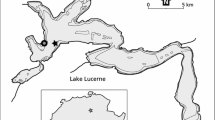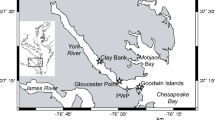Abstract
Measurements of microbial utilization of extracellular organic carbon (EOC) released by phytoplankton commonly consider only EOC fractions subject to rapid uptake. Questions remain whether other EOC fractions are metabolized, what portion is labile, and with what assimilation efficiency this carbon substrate is utilized. 14C-EOC was prepared by incubation of the natural mixed planktonic community from an oligotrophic lake with H14CO3 in the light. 14C-EOC which was not rapidly removed by heterotrophs remained in solution and was isolated by filtration. This residual EOC was inoculated with lake microheterotrophs in laboratory microcosms, and utilization kinetics were determined through long-term assays of cumulative 14CO2 production. Time-courses for 14CO2 production were consistent for all assays and were well described by a deterministic mixed-order degradation model. On twelve sampling occasions, from 29% to 76% of residual 14C-EOC was labile to further metabolism by lake heterotrophs. First-order rate constants for EOC utilization showed a mode of 0.05 to 0.15 per day. From 33% to 78% of gross 14C-EOC uptake was respired (mean 50%), indicating appreciable return of algal EOC to the pelagic food web as microbial biomass.
Similar content being viewed by others
References
Azam, F., T. Fenchel, J. G. Field, J. S. Gray, L. A. Meyer-Reil & F. Thingstad, 1983. The ecological role of water-column microbes in the sea. Mar. Ecol. prog. Ser. 10: 257–263.
Bell, R. T. & J. Kuparinen, 1984. Assessing phytoplankton and bacterioplankton production during early spring in Lake Erken, Sweden. Appl. envir. Microbiol. 48: 1221–1230.
Bell, W. H., 1980. Bacterial utilization of algal extracellular products. 1. The kinetic approach. Limnol. Oceanogr. 25: 1007–1020.
Bell, W. H., 1984. Bacterial adaptation to low-nutrient conditions as studied with algal extracellular products. Microb. Ecol. 10: 217–230.
Berman, T. & B. Kaplan, 1984. Diffusion chamber studies of carbon flux from living algae to heterotrophic bacteria. Hydrobiologia 108: 127–134.
Bjørnsen, P. K., 1986. Bacterioplankton growth yield in continuous seawater cultures. Mar. Ecol. prog. Ser. 30: 191–196.
Brock, T. D. & J. Clyne, 1984. Significance of algal excretory products for growth of epilimnetic bacteria. Appl. envir. Microbiol. 47(4): 731–734.
Brunner, W. & D. D. Focht, 1984. Deterministic three-half-order kinetic model for microbial degradation of added carbon substrates in soil. Appl envir. Microbiol. 47: 167–172.
Buddemeyer, E. U., G. M. Wells, R. Hutchinson, M. D. Cooper & G. S. Johnston, 1978. Radiometric estimation of the replication time of bacteria in culture: An objective and precise approach to quantitative microbiology. J. Nucl. Med. 19: 619–625.
Chrost, R. J. & M. A. Faust, 1983. Organic carbon release by phytoplankton: its composition and utilization by bacterioplankton. J. Plankton Res. 5: 477–493.
Cole, J. J., G. E. Likens & D. L. Strayer, 1982. Photosynthetically produced dissolved organic carbon: An important carbon source for planktonic bacteria. Limnol. Oceanogr. 27: 1080–1090.
Coveney, M. F., 1982. Bacterial uptake of photosynthetic carbon from freshwater phytoplankton. Oikos 38: 8–20.
Coveney, M. F. & R. G. Wetzel, 1984. Improved double-vial radiorespirometric technique for mineralization of 14C-labeled substrates. Appl. envir. Microbiol. 47: 1154–1157.
Ducklow, H. W., D. A. Purdie, P. J. LeB. Williams & J. M. Davies, 1986. Bacterioplankton: a sink for carbon in a coastal marine plankton community. Science 232: 865–867.
Fuhrman, J. A., R. W. Eppley, Å. Hagström & F. Azam, 1985. Diel variations in bacterioplankton, phytoplankton, and related parameters in the Southern California Bight. Mar. Ecol. prog. Ser. 27: 9–20.
Hobbie, J. E. & C. C. Crawford, 1969. Respiration corrections for bacterial uptake of dissolved organic compounds in natural waters. Limnol. Oceanogr. 14: 528–532.
Hoppe, H. G., 1978. Relations between active bacteria and heterotrophic potential in the sea. Neth. J. Sea Res. 12: 78–98.
Iturriaga R. & H.-G. Hoppe, 1977. Observations of heterotrophic activity on photoassimilated organic matter. Mar. Biol. 40: 101–108.
Iturriaga, R. & A. Zsolnay, 1983. Heterotrophic uptake and transformation of phytoplankton extracellular products. Bot. Mar. 26: 375–381.
Jensen, L. M., 1983. Phytoplankton release of extracellular organic carbon, molecular weight composition, and bacterial assimilation. Mar. Ecol. prog. Ser. 11: 39–48.
Jensen, L. M., N. O. G. Jørgensen & M. Søndergaard, 1985. Specific activity. Significance in estimating release rates of extracellular dissolved organic carbon (EOC) by algae. Verh. int. Ver. Limnol. 22: 2893–2897.
Kato, K. & H.-H, Stabel, 1984. Studies on the carbon flux from phyto- to bacterioplankton communities in Lake Constance. Arch. Hydrobiol. 102: 177–192.
King, G. M. & T. Berman, 1984. Potential effects of isotopic dilution on apparent respiration in 14C heterotrophy experiments. Mar. Ecol. prog. Ser. 19: 175–180.
Lancelot, C., 1984. Extracellular release of small and large molecules by phytoplankton in the Southern Bight of the North Sea. Estuarine, Coastal and Shelf Science 18: 65–77.
Larsson, U. & Å. Hagstrom, 1982. Fractionated phytoplankton primary production, exudate release and bacterial production in a Baltic eutrophication gradient. Mar. Biol. 67: 57–70.
Lovell, C. R. & A. Konopka, 1985. Excretion of photosynthetically fixed organic carbon by metalimnetic phytoplankton. Microb. Ecol. 11: 1–9.
McKinley, V. L., T. W. Federle & J. R. Vestal, 1983. Improvements in and environmental applications of double-vial radiorespirometry for the study of microbial mineralization. Appl. envir. Microbiol. 45: 255–259.
Payne, W. J., 1970. Energy yields and growth of heterotrophs. Ann. Rev. Microbiol. 24: 17–52.
Riemann, B. & M. Søndergaard, 1984a. Measurements of diel rates of bacterial secondary production in aquatic environments. Appl. envir. Microbiol 47: 632–638.
Riemann, B. & M. Søndergaard, 1984b. Bacterial growth in relation to phytoplankton primary production and extracellular release of organic carbon. In J. E. Hobbie & P. J. leB. Williams (eds), Heterotrophic Activity in the Sea. Plenum press, N.Y.: 233–248.
Riemann, B., M. Søndergaard, H.-H. Schierup, S. Bosselmann, G. Christensen, J. Hansen & B. Nielsen, 1982. Carbon metabolism during a spring diatom bloom in the eutrophic Lake Mosso. Int. Reveu ges. Hydrobiol. 67: 145–185.
Scavia, D. & G. A. Laird, 1987. Bacterioplankton in Lake Michigan: dynamics, controls, and significance to carbon flux. Limnol. Oceanogr. 32: 1017–1033.
Scow, K. M., S. Simkins & M. Alexander, 1986. Kinetics of mineralization of organic compounds at low concentrations in soil. Appl. envir. Microbiol. 51: 1028–1035.
Simkins, S. & M. Alexander, 1984. Models for mineralization kinetics with the variables of substrate concentration and population density. Appl. envir. Microbiol. 47: 1299–1306.
Søndergaard, M. & H.-H. Schierup, 1982. Release of extracellular organic carbon during a diatom bloom in Lake Mossø: molecular weight fractionation. Freshwat. Biol. 12: 313–320.
Storch, T. A. & G. W. Saunders, 1978. Phytoplankton extracellular release and its relation to the seasonal cycle of dissolved organic carbon in a eutrophic lake. Limnol. Oceanogr. 23: 112–119.
Valley, G. & L.F. Rettger, 1927. The influence of carbon dioxide on bacteria. J. Bact. 14: 101–137.
Walker, H. H., 1932. Carbon dioxide as a factor affecting lag in bacterial growth. Science 76: 602–604.
Wetzel, R. G., 1983. Limnology. 2nd Ed. W. B. Saunders Co. 860 p.
Williams, P. J. LeB., 1984. Bacterial production in the marine food chain: the emperor's new suit of clothes? In Fasham, M. J. R. (Ed.), Flows of Energy and Materials in Marine Ecosystems: Theory and Practice. Plenum Press, N.Y.: 271–299.
Wolter, K., 1982. Bacterial incorporation of organic substances released by natural phytoplankton populations. Mar. Ecol. prog. Ser. 7: 287–295.
Author information
Authors and Affiliations
Additional information
Contribution No. 596, W. K. Kellogg Biological Station, Michigan State University.
Rights and permissions
About this article
Cite this article
Coveney, M.F., Wetzel, R.G. Bacterial metabolism of algal extracellular carbon. Hydrobiologia 173, 141–149 (1989). https://doi.org/10.1007/BF00015524
Issue Date:
DOI: https://doi.org/10.1007/BF00015524




